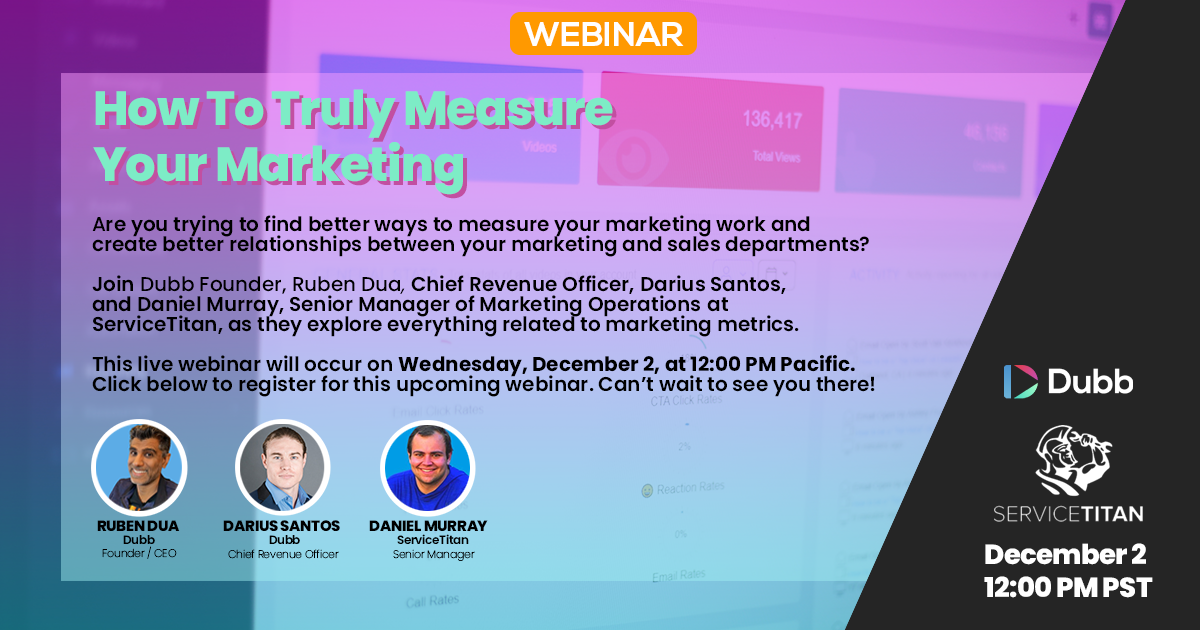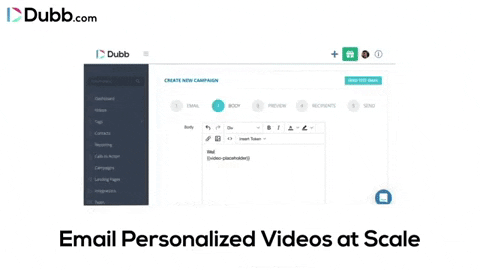Have you been searching for a better way to measure your marketing work?
Or have you noticed that your marketing and sales teams have had a consistently frosty relationship?
Marketers have an extremely important role to play in any business. Yet there are too many times where marketers are using the wrong metrics to measure themselves.
These off-kilter metrics can not only impair their day-to-day work but can create difficult relationships with their sales colleagues. Before you know it, these difficult relationships can lead to inefficiencies and poor corporate culture. Ultimately, there is a better way.
To learn about these marketing metrics and how you can create great relationships between sales and marketing professionals, we invite you to join us in an upcoming webinar.
In the webinar, you will hear from Dubb’s Founder, Ruben Dua, Chief Revenue Officer, Darius Santos, and Daniel Murray.
Daniel is a Senior Manager of Marketing Operations at ServiceTitan, which is the world’s leading all-in-one software for commercial and residential HVAC, plumbing, electrical, and other field service businesses.
This webinar is an outstanding opportunity for you to learn about both the metrics marketers should be measured on why measuring the wrong metrics creates all types of bad behaviors.
No matter the sector or industry of your business, this is absolutely critical information in a remote-first world.
Marketing is an integral component of any strong and successful business. Business is becoming increasingly competitive, and the only organizations continuing to thrive and survive are the ones with the most innovative, adaptable, and proactive marketers.
At its core, marketing is responsible for building a brand that lasts. But how do we determine if our marketing efforts are helping us achieve that?
A common theme in marketing is that measuring success calls for calculating the number of leads acquired.
For so long, we’ve known this whole idea of a funnel that’s composed of marketing qualified leads, sales qualified leads, opportunities, and clients. Accordingly, we focus on creating content and forming communities. But while providing value to your audience by publishing content is the best way to market your brand, measuring your marketing efforts’ effectiveness on irrelevant metrics—particularly leads—is not ideal.
Why? Because they’re simply not the most valuable information.
If you present a total number of acquired leads to your company’s executives, they probably wouldn’t consider it helpful, let alone relevant, as these metrics are in no way reflective of return on investment (ROI).
However, I’m not saying that we shouldn’t put emphasis and importance on generating those metrics. Because we all know that hand raises, form fills, and even webinar registrants are practically on the path to becoming conversions.
What I’m suggesting is that you begin embracing a revenue-first and client-first approach to measuring your marketing.
To learn about the marketing metrics that matter most, we invited Daniel Murray to speak at one of Dubb’s training webinars.

Daniel works as the Senior Manager of Marketing Operations at ServiceTitan, the world’s leading and fastest-growing software for commercial and residential HVAC, plumbing, electrical, and other field service businesses. Before ServiceTitan, Daniel worked in marketing for ChowNow, Oracle, SnackNation, and the Corrao Group.
Along with Daniel Murray, the webinar was co-hosted by Dubb chief revenue officer Darius Santos and myself, Dubb founder Ruben Dua.
Let’s get into this.
Marketing Metrics You Should Be Measuring
Efficiency of Touchpoints
First, let’s discuss touchpoint attribution. This means identifying where your prospects or clients are coming from.
Do they come from Facebook? Did your clients discover you from YouTube, or did they hear about you on LinkedIn?
Figuring out where your folks are coming from is the first step to constructing a touchpoint attribution model. Touchpoints are the channels that drive interest, interaction, and traffic. They are any modes or methods of contact between you and your consumers.
If you can look at your reporting to see where folks entered and how they converted in the buyer’s journey, you’ll be getting a two-touchpoint attribution model.
Once you’ve established this, you can then start to create pathways. The most effective and most optimized pathways—the ones where people learned about you and where they ultimately converted—are what you should invest most of your dollars in. Because when you know where your metrics are, you know where you’re getting the best ROI. And where you’re getting the best ROI is what you should be investing the most resources in.
Here at Dubb, we’re all about content. Frankly, we’ve never had success in conducting cold outbound efforts. And for this reason, we’ve grown into being a content-driven and community-focused company. Content and community are in our company’s DNA.
However, if you visit any of our channels, you’ll notice that there are tracking data on every single one of the links that redirect users to Dubb’s website.
Yes, we’re focused on content. But we’re hyperfocused on data attribution.
I recommend that you also get your UTM data parameters on all of your links so that you can track the effectiveness of your online marketing campaigns. Getting your data tracking parameters is crucial. I would even go as far as to say that you should make it your religion. Because again, it lets you know where you should be investing your money.
Now, if you don’t have the proprietary technology on your website for measuring this data, that shouldn’t be a problem. You can configure your Google Analytics instead.
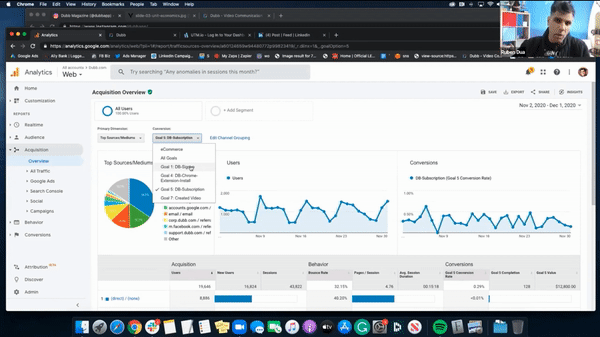
We have data tracking parameters set up throughout our entire tech platform. If you visit Dubb’s Instagram page, you’ll see what appears to be a branded URL. If a user clicks on it, the UTM will follow the user throughout their whole experience on Dubb.
Our mantra isn’t MQLs, SQLs, and opportunities. It’s signups, subscriptions, and upgrades.
If I go into Google Analytics, I can see exactly where the signups, subscriptions, and upgrades are coming from. You can start doing this too. In case you were wondering, we generate our trackable URLs from a tool called utm.io.
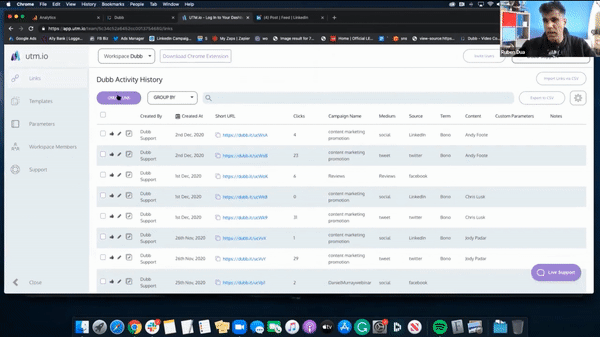
Churn Rate
Aside from touchpoint efficiency, it’s essential to observe your funnel’s churn rate.
This requires understanding your ideal customer profile. The ideal customer is someone you know won’t churn down the funnel, someone you know whose willingness to buy is better than others.
To illustrate, ServiceTitan only serves a specific type of customer profile. Because of this, they set up form fields composed of data that prove whether someone doesn’t fit into their ideal customer profile and if they will churn down the line.
Determining where your clients are coming from goes hand in hand with understanding who your clients are. Let’s face it, acquiring customers wouldn’t matter if they churned one or two months later. So, you have to know how efficient your channels are and how long your clients are staying as customers.
Revenue
Another necessary metric to measure is the customer lifetime value to customer acquisition ratio (LTV:CAC). It’s a great indicator of sustainable growth, and it helps you determine how much or how little you should spend on your marketing efforts to boost that growth.
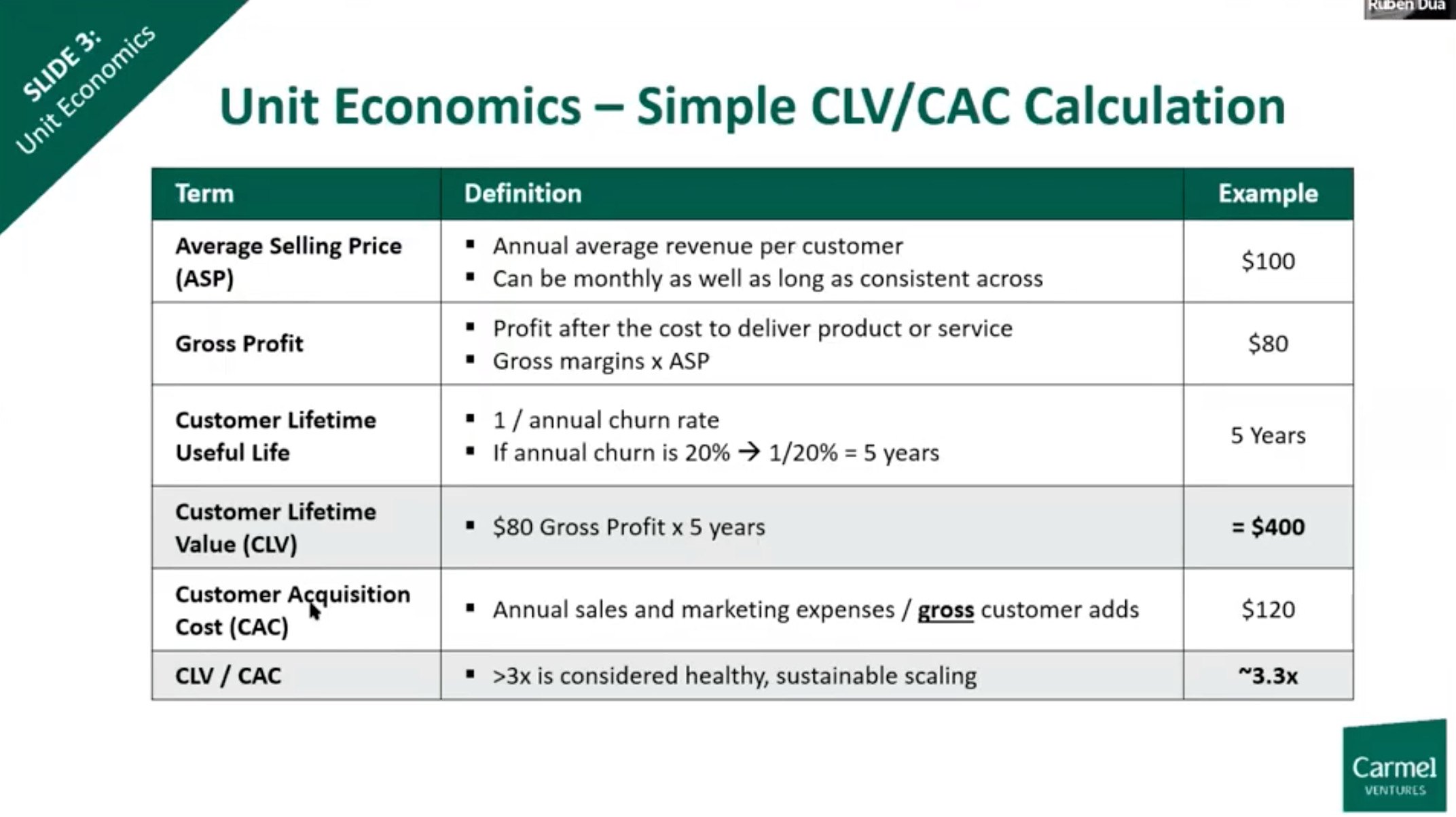
- Lifetime Value (LTV or CLV) is the average revenue that a customer will generate for your business throughout their lifespan of being your customer.
- Customer Acquisition Cost (CAC) is the expense of winning over a new customer to purchase your product or avail of your service.
A good LTV to CAC ratio is 3:1. The value of a customer should be three times more than the cost of acquiring them.
Suppose the LTV of a customer is $3,000, and it cost you $1,000 to acquire that customer. Your LTV to CAC ratio would be 3:1. If your LTV amounts to over $5,000, for instance, then your ratio becomes 5:1, which means you can create more opportunities by spending more.
Going back to the topic of churn rates, remember that it’s way harder and way more expensive to bring in a new customer than it is to keep an existing customer.
So, spend money to keep your customers happy. Once your lifetime value starts to go up, start spending even more to acquire more customers because you know that they will stay longer.
Lifetime value and customer acquisition cost might be metrics that you find challenging to calculate, but know that these will help you in the long run. It may all sound complicated, but it’s important to work on this upfront.
Let’s be real here. You aren’t planning on going into business for only a year. None of us are. If you plan on being around for the long term, you have to calculate these key performance indicators.
Not sure about where to start or which tool to use? That’s fine. None of these are out of your range. You can begin tracking these metrics in something as easy and simple as a spreadsheet.
Unmeasurable Marketing
Not all marketing can be measured objectively.
While it’s crucial to understand these metrics, in the end, marketing should still be simplified down to its basics: Be creative, stand out, understand your customer, and provide value.
I believe this is where the way of the Jeet Kune Do comes in. Bruce Lee founded Jeet Kune Do as a martial arts system that strays from the traditional and instead encourages simplicity, directness, and freedom.
As a philosophy, Jeet Kune Do advocates for minimal effort to achieve maximum effect. It implies that although you learn many different practices and methods, in time, you only have to use what works.
Within the context of marketing, it means that when you put in the work to set up your attribution, your trackable links, and data reporting, you’re allowing yourself to then focus on what truly matters: your brand.
Learn all of these rules and metrics and put them into place. But realize that you’re going to have to transcend them and just trust in the system at some point.
Because while there are some metrics to measure your marketing success, a lot of marketing is still unmeasurable. The most significant of which is word of mouth.
Your Customers are Your Best Marketers
53% of Dubb’s revenue comes from word of mouth. Despite being unmeasurable, I delight in that because it equates to brand. It means that conversations are being had that are centered around the brand and community we’re building. And that’s the most valuable thing that we as business people and marketers could do—build community and build a brand.
Half of your data might be attributed, but the other half is the best type of data—that which comes from word of mouth, referrals, content, and community that results in commerce.
You can look at your data, see that your SEO is doing excellent and brand searches are climbing, and automatically assume that it’s because of your Facebook ads and other paid media, but it could simply mean that people are loving your product and are talking about it. Sometimes, your success could only stem from the fact that people share your content because they find it valuable.
Think of the brands that are surviving today. They’re the brands that have spent the past several years creating a long sustaining brand. And a “brand” isn’t easy to measure.
The number one metric for every company must be how much they are able to retain customers and make them happy.
When all is said and done, your customers are your best marketers.
Customers talk. If they encounter a bad experience working with you, they will leave and begin telling their friends. If they have a good experience with your products and services, they will tell other people.
This brings us back to why leads are a terrible metric. To be successful in marketing, you have to think of the buyer first. Leads cause you to do the exact opposite and make you create bad marketing efforts.
Let’s say your goal is a thousand leads. With this goal in mind, it’s probable that all you’re going to do is hand off content downloads and inundate with ads the people who aren’t even ready to buy from you yet. Your only focus would be convincing people to do business with you instead of helping them with their problems and needs.
Measuring leads is extremely seller-centric.
The ultimate goal of marketing is to guide people to come into your world, and its purpose is to serve as an avenue for you to educate them, provide value, and take them from a problem to a solution.
The most growth that Daniel has had on LinkedIn as a personal brand was from people talking about him. His providing value got people to talk about his posts and himself more and more. It’s worth noting that his content has nothing to do with him but everything to do with his clients and prospects.
The Sales and Marketing Relationship
When you have terrible, unqualified leads that you hand off to sales, your sales team is sure to eventually lose trust. Nobody will want to work marketing leads if they’re next to useless.
Marketing shouldn’t be seen as a sales support function. We should regard it as a revenue-driving function.
Marketing is meant to make sales easier.
Therefore, you have to make it a priority to find the best buyers for your sales team. And to do this, you need superb marketing efforts.
Funnel vs. Flywheel
As a marketer, I’m sure you already know by heart what a sales funnel looks like. Although some parts of it might vary from business to business, its essence remains the same.
While it might have helped many in the past, it might be time to scratch the idea of a funnel. Because if you think about it, the funnel involves people coming in and people coming out.
It’s better to switch to the flywheel.
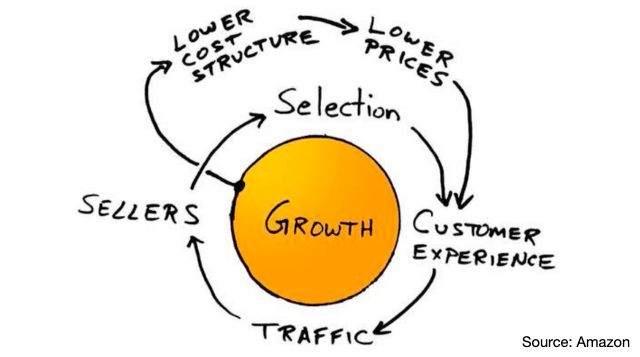
The flywheel suggests that when someone becomes a customer, that’s a chance to get even more customers. In essence, it’s a growth loop that prioritizes customer-centricity.
Understanding Your Buyer
Upholding these measurable and unmeasurable metrics ultimately comes down to understanding how a buyer buys.
When a buyer comes to your website and signs up for a demo or a free trial, they’ve already made the decision that they want your product. They’ve already pre-researched before they decided they wanted to get a demo.
And so, a little reminder from Daniel to every marketer out there: Running ads on an awareness-based channel telling people to try out a demo is a lousy strategy because people aren’t ready to buy on top of the funnel. You first have to nurture them.
This is why creating content is one of the best plays in marketing—especially video.
Video is the most authentic way to build trust one-on-one with your ideal client profile. If you look around, you will notice that the highest performing ads have a video on them.
What makes videos so effective in building trust?
When leads get into the funnel, you want to create a bond between them and your sales reps. You might have heard this a thousand times before, but it only gets more true every day: People buy from people. They don’t buy from companies. A company never assigned a check.
By communicating with video, this relationship is developed, maintained, and further strengthened.
Here at Dubb, we believe in the power of video to bridge boundaries and communicate messages that connect to people. We’ve learned that videos are capable of maintaining that “human touch” that buyers are looking for.
Our platform is dedicated to marketers looking to market their brand, grow their business, and provide value to people because we know that marketing is all about putting people first.
And now, allow me to explain how you can use Dubb to create actionable, trackable, and high-value videos for your marketing efforts.
How to Use Dubb to Improve Your Marketing Game
Three words you have to remember about Dubb: creation, customization, and distribution. These are the components that make up the whole process of video communication. Dubb allows you to do all three in one easy-to-use platform.
Like Jeet Kune Do, our goal with Dubb is to help you create and publish videos with little to no effort and yet still achieve maximum effect and obtain many great opportunities. This way, you can spend most of your time and energy working on building your brand, participating in conversations, getting to know people, and other tasks that matter.
Creation
Dubb Chrome Extension
Dubb’s Chrome Extension allows you to create a screen recording video from wherever you’re at with just a few clicks.
Aside from recording your screen, you can also include your webcam feed, which will be placed on the lower-left corner of your screen. But if you’re feeling a bit camera-shy, you can choose to record just your voice.
Suppose you wanted to prospect someone on LinkedIn. The Dubb Chrome Extension is your best bet. Hit record, wait for the countdown to end, and you’re live. In addition to recording your entire screen, it also has annotation features that you can use to make the video more engaging.

Again, you can use the Chrome Extension anywhere. It isn’t limited to LinkedIn; you can just as easily screen record browsing through a prospect’s website or something of yours that you want to show them. If the computer screen isn’t necessary, you can choose to record just your face and your voice.
If you already have a pre-recorded video in your file library, you can upload that to Dubb as well. Should you wish to send out an already existing video from YouTube, you can also do that by use of the Dubb Chrome Extension.
Dubb Mobile App
If recording on a computer isn’t your thing, or you’re always on-the-go, you can check out the Dubb mobile app available for iOS and Android.

It’s not your typical video recording app. Dubb for mobile offers real-time editing features. You can splice clips together, add text, emojis, and music, all in this one user-friendly app.
After shooting and editing your video, you can upload that straight to Dubb, and it will be the same process as if you used the Chrome Extension on your computer.
Customization
Now that we’ve got the creation part out of the way, the next step is to customize your video’s design elements.
Video Landing Pages
After uploading a video, Dubb automatically packages them into a landing page that effectively communicates your branding—complete with your brand’s logo, watermark, color scheme, and a background image of your choosing.
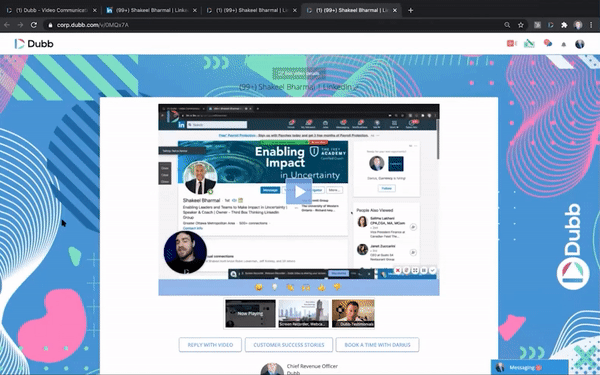
This way, your video is presented in a design specific to your brand, business, and goals.
Video Playlists
Your video landing page will include a video playlist where you can add as many videos as you want.
Dubb’s video playlist is very different from when you’re only uploading a video to YouTube. YouTube suggests content from other brands after one video finishes playing. But with Dubb, you have complete control of what shows up on your playlist, and you can guarantee that your prospects are only consuming your material.
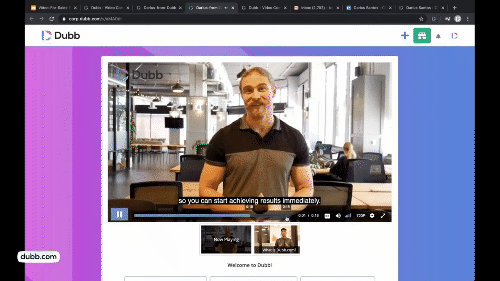
Now, these videos will play back-to-back without the user having to click on anything. They wouldn’t even be redirected to a separate page after the first video is done playing. With Dubb’s playlist feature, your videos are all on one landing page, playing the next as soon as the previous finishes in a very seamless fashion.
Apart from being an effective tool to capture and maintain the viewer’s attention, the video playlist is also useful for warming up a cold lead or even nudging a more qualified lead in the right direction.
How? By arranging a sequence of different types of videos that make up a comprehensive whole.
After a LinkedIn screen recording video, you can place a pre-recorded and heavily produced explainer video to help your recipients learn more about your services. And to take things a step further, you can end the playlist with video testimonials, case studies, demos, or social proofs. Now, these are only examples. You can add any type of video you wish to add, whatever you think will help you earn the trust of your prospects.
Call-to-Action Buttons
Of course, the reason why you’re marketing and creating videos is to encourage your contacts to take action and participate in your business as valued clients. The best way to achieve this is by presenting them with call-to-action (“CTA”) buttons.

Dubb’s CTAs can do just about anything you can think of. Some of the most common CTA buttons are for filling out a form, downloading an attachment, booking a call, recording video testimonials, and sending a text message. But you’re not limited to these options. You can configure your CTAs to be anything you want your recipient to do after watching your video.
Video Presets
Dubb’s customization power doesn’t end with the CTA buttons.
With Dubb’s video page presets, you can instantly customize your landing pages for different use cases. All you have to do is construct multiple templates upfront. You can change everything from the background image to the video playlist. Presets are particularly helpful when you’re managing different marketing roles and you need to send out different sets of videos for various purposes.
You have the option to change a few specific elements of your landing page if only minor tweaks are required, but presets are particularly useful for changing the entire page in one click.
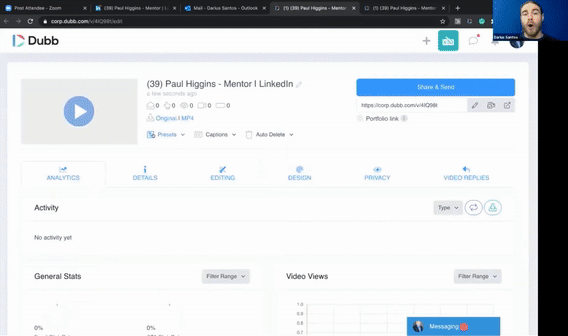
Distribution
You’ve finished creating and uploading your videos, packaged them in your design elements, set up your video playlists, and configured your CTAs. What’s next? It’s time to send your videos out to your contacts.
Direct Integration
Whatever methods of communication you’ve already been using, Dubb is going to meet you right where you are.
First, let’s explore Dubb’s direct integration with LinkedIn.

If you’re planning on sending your video message to someone on LinkedIn, all you need to do is look for the small Dubb icon. You can find this wherever you can send a message or write in text.
Once you click on the icon, it will give you access to your library of videos so that you can insert anything you’ve previously recorded. You can also access Dubb’s recording features by clicking on the icon, which allows you to capture a fresh video right inside of LinkedIn.
After choosing a video message to send out, Dubb will display it as an animated GIF preview of the first three seconds, which is a whole lot more engaging and eye-catching than a still image thumbnail.
LinkedIn isn’t the only platform that Dubb has direct integration with. You can also access Dubb straight from Gmail, Outlook, HubSpot, Salesforce, Mailchimp—you name it. Dubb has direct integration with every major email service provider and CRM platform.
Universal Share and Send
Whether you’re sending your video messages through a CRM or a social media platform, they can still appear as animated GIF previews—even when you’re not sending via direct integration.
With the universal copy for email method, you can distribute your video messages anywhere you can paste a message into. Just click copy, and then paste it into any medium. You can use this to send out via text messages, social media, and any other channel that doesn’t directly integrate with Dubb.
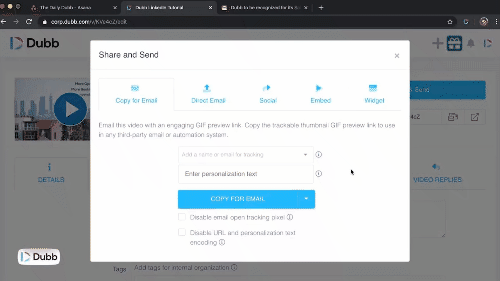
Automation and Campaigns
The last distribution options are marketing automation and bulk campaigns.
Dubb lets you send messages similar to how you would do so using HubSpot or Marketo. The first step is to connect your email client to Dubb, whether Gmail, Outlook, or whatever you’re using. After linking your email, you can then send out video messages either in bulk or through automation.
Sending in bulk email campaigns means distributing your message to multiple recipients at one time. In addition to bulk emails, there are also bulk SMS campaigns. It’s essentially the same thing, only with text messages. Both of these distribution methods can be arranged directly inside of Dubb.
On the other hand, automation involves a series of emails or text messages that will go out automatically. Its primary difference from campaigns is that it uses workflows composed of triggers and delays. Automated messages can also vary for each recipient if the marketer chooses to incorporate if/then statements. The messages will change depending on user behavior or interaction with the material.
Tracking and Analytics
Last but definitely not least, tracking and analytics. It’s not a method of distribution but a necessary component.
We know how important it is to be able to monitor the activity that your content is receiving. This entire discussion has been about marketing metrics, after all.
For every video that you send out using Dubb, you’ll be able to see who among your contacts watched, what percentage of the video they watched, which CTAs they interacted with after they finished watching, and many more valuable data like email click rates, call rates, and video views.
![]()
It doesn’t matter if you used direct integration or the universal copy and paste method to distribute your videos—Dubb will always allow you the ability to observe your activity reporting.
That’s it. That’s how you can use Dubb to streamline your communication and improve your marketing efforts with video.
Measuring the Right Metrics
How you measure your marketing must be revenue-driven and, more importantly, customer-centric. Every marketing strategy you come up with should revolve around the idea of catering to your clients’ needs.
Moreover, remember that these rules and tips for measuring your metrics aren’t only for large companies. They also apply to small businesses, agencies, and even solopreneurs.
If you’re a small business owner or a solopreneur who’s only starting out, keep in mind that creating a brand, generating awareness, and attaining longevity are not unattainable. You can accomplish these goals in the same way that the most prominent organizations are doing.
Above all, don’t get too consumed with the need to measure everything. Sometimes, it’s better to just be a better marketer and find creative ways to make your customers happy.
If you’re ready to begin creating videos that drive conversions, sign up for a free 14-day trial of Dubb here. For questions, you may reach out to us here.

